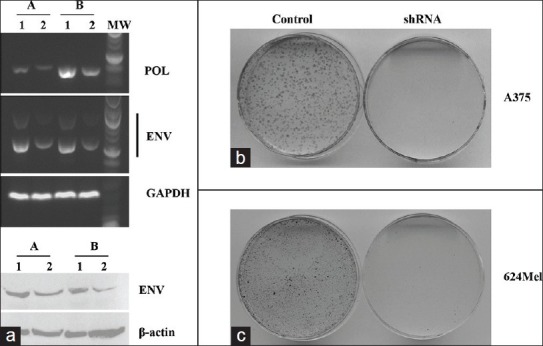Figure 2.

Inhibition of K type human endogenous retrovirus (HERV-K) expression blocks intercellular fusion-mediated colony formation. Human melanoma cell line A375 (a) and 624Mel (b) was transiently transfected and selected to stably express either control pS-puro-scrambled (1) or HERV-K shRNA pS-puro-H-Ki construct (2). (a). RT-polymerase chain reaction (RT-PCR) using total cellular RNA was performed using specific HERV-K POL and envelope (ENV) primers as described (15). Gel electrophoresis of RT-PCR products revealed that POL and ENV RNA levels were reduced in shRNA expressing cells of both A375 (a) and 624Mel (b) cells. GAPDH was used as internal control (b). Western blot analysis of HERV-K ENV protein. Total cellular protein was separated on SDS-PAGE, and blotted to Nilon membrane, and incubated with HERV-K ENV antibody. Actin was used as loading control. As expected, HERV-K POL and ENV transcripts (a) and ENV protein (b) levels were reduced in cells expressing shRNA. The knockdown levels of both RNA (a) and protein (b) were estimated as more than 50% (c). To examine cell fusion, 106 A375 or 624Mel cells stably expressing pEYFP-N3 were mixed with equal numbers of the same cells expressing either pS-puro-scrambled or pS-puro-H-Ki. Mixed cells were cultured to confluency in medium without puromycin or G418 selection. Cells were then trypsinized and passaged in culture medium that includes both puromycin and G418 to select pS-puro-scrambled-pEYFP-N3 and pS-puro-H-Ki-pEYFP-N3 fused cells. Colony formation assay was used to count “fused” clones under double selection
